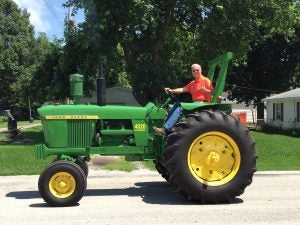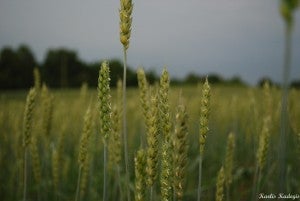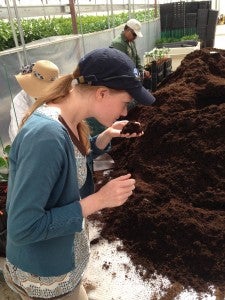Establishing a cover crop during the cool season.In early December, the EDF climate-smart agriculture team will join hundreds of farmers, food and agriculture companies, university experts and other conservation organizations at the 2023 Sustainable Agriculture Summit, “Scaling Collective Impact: Collaborating to Accelerate Agricultural Sustainability.” This conference is one of the largest annual gatherings of people working to improve sustainability in U.S. agriculture, and the discussions held in the conference sessions and hallways reflect the major trends, opportunities and challenges facing those who share this goal.Here are some expected “hot topic” discussions at the conference and throughout the agricultural sustainability movement as we approach 2024.
Growing Returns
Selected tag(s): sustainable
Trends to scale collective impact at the 2023 Sustainable Agriculture Summit and beyond
This Illinois farmer is breaking down siloes. Here’s how.
 My first impression of Len Corzine was that he isn’t the kind of guy who sits back and waits for people to bring him ideas on how to innovate or improve stewardship – he actively searches for them himself. He then shares these ideas with peers and colleagues.
My first impression of Len Corzine was that he isn’t the kind of guy who sits back and waits for people to bring him ideas on how to innovate or improve stewardship – he actively searches for them himself. He then shares these ideas with peers and colleagues.
When I visited Len’s farm in Assumption, Illinois, five years ago, I immediately saw that Len was an early adopter of tools and technologies to help him grow more with less. Like a kid with a brand new bike, Len could not wait to show me the computer software he was using for soil samples and variable rate application of nutrients, or the maps that helped guide his every decision.
To date, Len’s farm has reduced soil erosion, cut fertilizer use per bushel by half, and adopted satellite-guidance technology in its tractors to reduce fuel and chemical use. All while yield productivity has increased 80 percent. Read More
New climate change report is an urgent call to action for agriculture

Credit: Flickr user Bruno Monginoux
The USDA today released a new scientific assessment at the United Nations negotiations in Paris that found climate change will pose a significant threat to food security and to farmers.
National Public Radio’s Dan Charles said it best in his latest story:
“Chances are, you’ve picked up some chatter about the new global talks on climate change. If you can’t quite see how it matters to you, personally, you might want to take a peek inside your pantry. Or your candy jar. Because it might just affect your access to everything from cheese to chocolate.”
Today’s report represents an urgent call to action for food companies, policymakers and agribusinesses to collaborate in reducing emissions from food production and implementing farming practices that increase resilience.
We have the tools at our disposal to make sustainable agriculture a reality. But to implement these measures at scale, we need increased investment from the private sector and collaboration across the agricultural supply chain. We need to go beyond commitments and towards on-the-ground support for farmers. Read More
Why wastewater treatment plants are investing in farmers

Wastewater treatment plant. Credit: Flickr user Florida Water Daily.
The Des Moines Water Works lawsuit represents one of the most contentious challenges in modern-day agriculture: who should pay for protecting water quality from excessive nutrient loads?
Excess nutrients in streams and watersheds can cause algae blooms as well as air and water pollution. Whether due to excess fertilizer runoff from agriculture, urban sewage, stormwater runoff, or air depositions of nitrogen, wastewater treatment facilities often bear the primary responsibility of nutrient removal in many watersheds. Under the Clean Water Act, these facilities are charged with cleaning water to a certain standard, which can be increasingly hard to meet – and to pay for – when excess nutrients are present.
But there are some interesting solutions in the works.
I asked Pat Sinicropi, Senior Director of Legislative Affairs at the National Association of Clean Water Agencies (NACWA), to tell me about the collaborative approach her organization is taking to solve the problem – by working with farmers. Read More
Cutting food waste to support farmers and the famished

Surplus food at the Food Donation Connection. Photo Credit: USDA.
Food waste affects more than just our wallets. Approximately one-third of all food produced in the world gets thrown away every year, leading to 3.3 billion tons of greenhouse gas emissions. At 2.6 trillion pounds, that’s enough sustenance to feed three billion people, or almost all people living in poverty worldwide today.
That’s why, last week, when I attended a Q&A session for ag interns at the U.S. Department of Agriculture with Secretary Tom Vilsack, I was intrigued when a fellow intern asked a question regarding food sustainability and what the U.S. can do to ensure that there will be enough food to feed the 9 billion people expected to populate the world by 2050.
The Secretary’s answer? Reduce food waste.
Sustainability and profitability go hand-in-hand, says Iowa corn farmer

Tim Richter, owner of Saratoga Partnership.
Farming is a tough business. With constantly changing crop prices, difficult to predict and increasingly extreme weather variations, and changing consumer demands, growers don’t have an easy time of it.
Like any business, profitability is the number one priority. And it should be – if you are not profitable, it’s very hard to stay in business.
All the growers I’ve worked with care deeply about their land. In a recent survey of a group of Midwestern farmers, “land stewardship” ranked as their top value. And sustainability is in a farmers’ best interest since healthy lands plays a huge role in whether farms will be around – and productive – for the next generation. But making agriculture truly sustainable will require investment from farmers.
Here’s the good news: sustainability and profitability can go hand-in-hand. Efficiencies like fertilizer optimization can result in cost savings. And with those savings, growers can invest in new technologies and cover crops, which can help make farms more resilient and increase yields, generating long term economic gain.
I asked Tim Richter, owner of a swine and corn farm operation spanning 9,000 acres in northern Iowa and Missouri, to tell me his profitability and sustainability story. Read More
How cover crops can help growers beat droughts and floods
Corn is trying to fight this summer’s extreme weather, and unfortunately, the weather is winning.
There are serious floods in the Midwest, devastating droughts in California, and brutal heat waves along the eastern seaboard. Ohio for example had a record June rainfall of 11 inches, which stunted corn roots and prevented many growers from planting any corn crops. In Northwest Ohio alone, 100,000 acres were left unplanted. At the same time, places in my home state of North Carolina experienced a June heat wave during the critical corn pollination period, significantly damaging corn yields.
These extreme weather events leave many farmers searching for ways to make the best of a challenging growing season. Although June’s weather was the opposite in Ohio and North Carolina, cover crops offer a proven solution to deal with both conditions. Read More
Note to Congress: Pitting fish against farms won’t solve California’s drought
A bill to supposedly address California’s devastating drought, authored by Rep. David Valadao, cleared the House of Representatives today.
Unfortunately, this proposal – dubiously named the Western Water and American Food Security Act of 2015 – is yet another attempt to move more water through California’s vast Central Valley Project at a time when we can least afford it and at the expense of many water users.
Among other problems, the bill would permanently undermine science-based protections and regulatory assurances for at-risk species and ecosystems that are essential in providing reliable food, safe drinking water, and jobs to millions of Americans.
The proposed tradeoffs here are nothing new. Similar bills – H.R. 3964 and 5781 in 2014, both opposed by the White House and the State of California – also pitted fish against farms.
It’s time we move away from finger pointing and start finding collaborative solutions to the drought that increase the resiliency of our freshwater ecosystems while supporting agricultural communities in California’s Central Valley. Read More
What a visit with a California citrus grower taught me about agricultural sustainability
Putting yourself in the boots of a California farmer will give you a whole new perspective.
That’s why I recently spent a few days alongside Matt Fisher, a citrus grower in Kern County, California – to better understand growers’ challenges and concerns, and to rethink how environmental groups and farmers can achieve shared goals.
The experience was part of a farm exchange program offered through the California Agricultural Leadership Foundation, which facilitates learning opportunities on California farms.
With a record-breaking drought in California, tensions between environmentalists and farmers run high, and finger pointing is everywhere. But that isn’t getting us anywhere. The time I spent on Matt’s farm gave me new inspiration to break down barriers, put aside stereotypes, and work together. Read More












